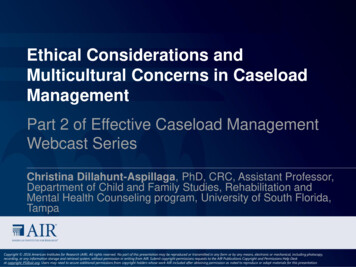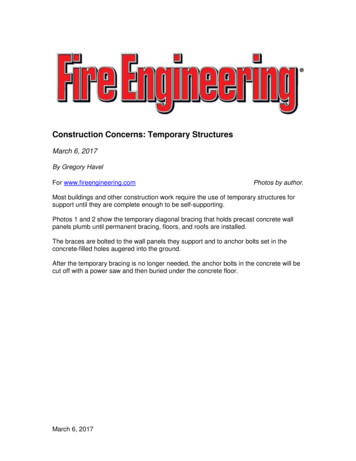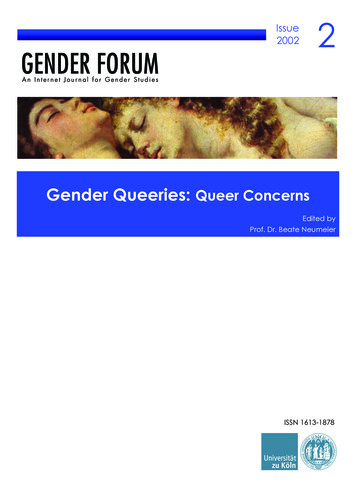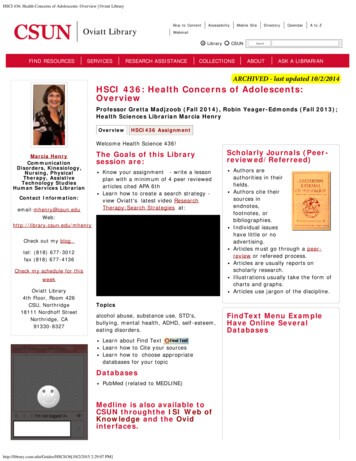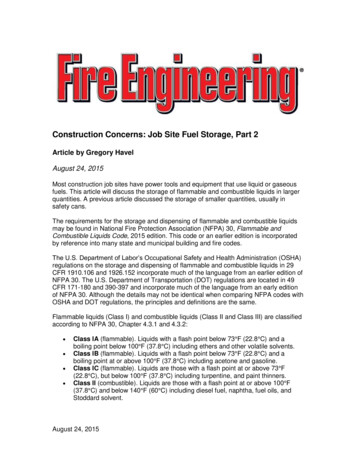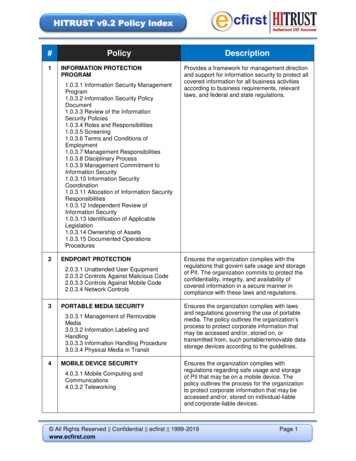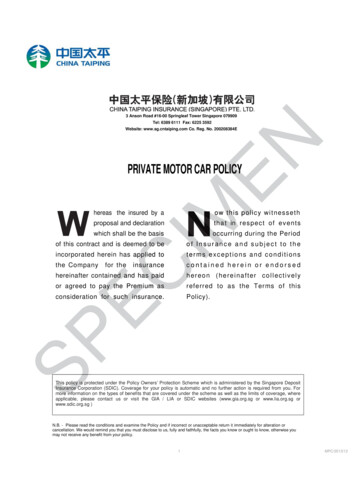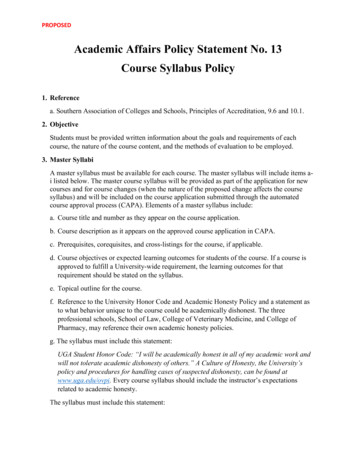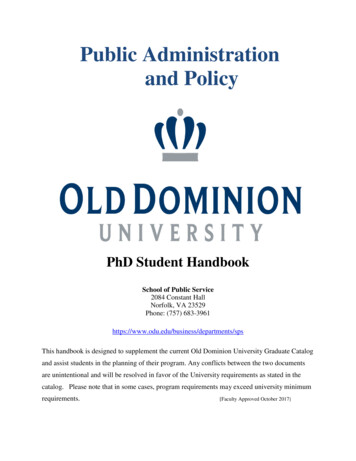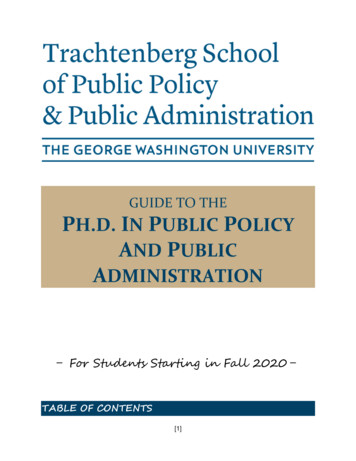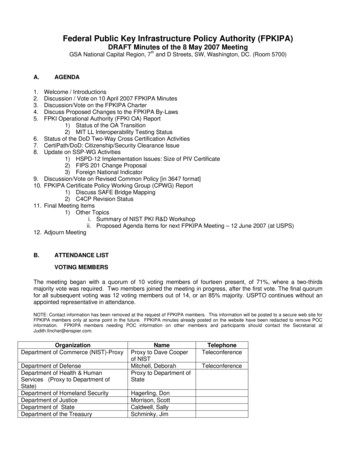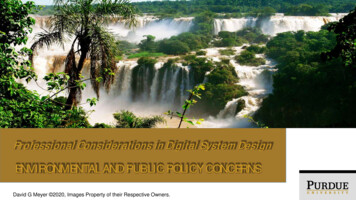
Transcription
Professional Considerations in Digital System DesignENVIRONMENTAL AND PUBLIC POLICY CONCERNSDavid G Meyer 2020, Images Property of their Respective Owners.
OUTLINE Why study environmental concerns?Basic environmental questionsWhere do our raw materials come from?Production and manufacturing costsThe consumer lifecycleE-waste and electronics recyclingWhat can be doneCase studies
WHY STUDY ENVIRONMENTAL CONCERNS? Accreditation agencies (ABET) deem it an important part of all engineeringcurricula, including EE and CmpE Idea of “best engineering practice” – environmental factors are an importantelement of this Engineers have vast power to oversee the creation and development ofdesigns and the environment, and thus have great responsibility to see toits care“It is expected that commonplace practice of sustainable developmentand business practice will evolve over time, either by choice orcatastrophe.” F. Splitt, Northwestern University
BASIC ENVIRONMENTAL QUESTIONS What are some of the environmental issues associated with themanufacture, use, and disposal of electronic devices? What obligation is there to lengthentheuseful lifetime of a product to theextentpossible? What obligation is there to reduce theenergy consumption of a product tothe extentpossible?
RAW MATERIALSIndiumWhat it’s used for: Transparent conductive coating for LCD panels,semiconductor applications, LEDs, anti-corrosion agent in batteriesWhere it can be found: Extremely rare, occurs only in the form of indiummineral compounds, none of which are known to occur in significantdeposits. Generally extracted from deposits of lead, tin,copper, iron, and zincWorldwide Production: 600 tonsEOL Recycling Rate: 1%Remaining known supplies: 14 years
RAW MATERIALSGalliumWhat it’s used for: High-speed semiconductor devices, high-powered lasers.Gallium arsenide (GaAs) and gallium nitride (GaN) are most common variants,accounting for 98% of commercial useWhere it can be found: Extremely rare, occurs only in the form of mineralcompounds which are themselves too rare to mine. Extracted as a trace elementfrom bauxite (aluminum ore) and sphalerite (zinc ore).Worldwide Production: 300 tonsEOL Recycling Rate: 50%Remaining known supplies: Significant, butrequire substantial mining to access
RAW MATERIALSTantalumWhat it’s used for: High reliability tantalum capacitors, found in phones,computers, tablets, and other consumer electronics.Where it can be found: Extremely rare, occurs in an estimated 1-2 ppm in theearth’s crust. Primary sources include Australia, China, and central Africa.Tantalum mining is linked to warfare and thus Tantalum from these regionsis considered a conflict mineralWorldwide Production: 1,600 tonsEOL Recycling Rate: 25%Remaining known supplies: 50 years
RAW MATERIALSLithiumWhat it’s used for: Primarily used in batteries due to its low weight and highenergy storage capabilitiesWhere it can be found: Rare, although can be extracted from seawater ormined from the earth’s crust in trace amounts ( 20 mg per kg of crust).Largest known source is the Salar de Uyuni (left) in Bolivia, containing50-70% of known global lithium reservesWorldwide Production: 20,000 tonsEOL Recycling Rate: 25%Remaining known supplies: 100 years
PRODUCTION AND MANUFACTURING Modern electronics require highly purified base materials which are rare, scarce,and challenging to extract. Due to the complex designs involved in integratedcircuits, the cost and material usage of electronics is much higher than manyother products. A single 2-gram DRAM chip uses an estimated 1.6 kg of “fossil” fuels and 72 g ofchemicals; large amounts of water (32 kg) are required as well.(Source: American Chemical Society)
CONSUMER LIFECYCLE Once products are manufactured and shipped, they are operated by end usersfor the intended application over the product’s usable lifecycle The primary environmental impact at this stage involves energy consumption In 2017, U.S. consumer electronics devices used an estimated 144 TWh of energy
E-WASTE AND RECYCLING Increased consumption and demand for electronics in modern society has led toenormous amounts of electronic waste (E-waste) In 2014, the United States alone generated an estimated 11.7 million tons of Ewaste, much of it sent to landfills (recycling rate is about 30%) Some E-waste is exported, largely from developed countries, to developing and poorcountries, for recycling Recycling of E-waste involves large amounts of labor withnumerous environmental and human hazards E-waste is often burned, producing byproducts such as leadfumes and metallic toxins, which are extremely dangerousto human health
WHAT CAN BE DONE As engineers, resource depletion and electronic waste can be mitigated in thefollowing steps: Eliminate: New devices and designs which eliminate the need for previouslyexisting classes of products (example: smartphones eliminating need for separateMP3 player) Reduce: New devices and designs which use fewer resources and energy than theirpredecessors Reuse: New devices and designs which are easilyrepairable, upgradeable, and multifunctional Recycle: Send remaining salvage to recyclers toresponsibly recycle old electronic materials
ENVIRONMENTAL & PUBLIC POLICY QUESTIONSProject Ara Google/Motorola initiative - modular smartphone design End users can decide which components and functionality their phones need,and purchase modules on this basis When an upgrade is desired or a repair needs to be made, the module can bereplaced without needing to discard the entire device Project Ara concept video: https://www.youtube.com/watch?v TQjGBEEiejU
ENVIRONMENTAL & PUBLIC POLICY QUESTIONSProject Ara Relevant questions: What are the positive environmental impacts of this project?Negative impacts? Would you buy a device like this? What premium would you bewilling to pay compared to a normal disposable device?
ENVIRONMENTAL & PUBLIC POLICY QUESTIONSEnergy Independence and Security Act of 2007Household Lighting It does not ban the use or purchase of incandescent bulbs. It does not ban the sale or manufacture of ALL incandescent bulbs, just those commonhousehold incandescent (and other) bulbs that are not energy-efficient. It does not require the use of compact fluorescent bulbs (but CFL was the onlytechnology available at the time the law went into effect that met the requirements) It requires about 25 percent greater efficiency (that is, 25 percent less energy use) for household light bulbs that havetraditionally used between 40 and 100 watts of electricity. Many bulbs, including specialty bulbs, three-way bulbs, chandelier bulbs, refrigerator bulbs, plant grow lights andothers, are exempt from the law's requirements. It was passed by Congress and is implemented by the U.S. Department of Energy (DOE).Regulatory Updates Since the 2007 Law Went Into Effect In January 2017, DOE issued two regulations to expand the scope of the 2007 law to include incandescent reflectorbulbs and candle-shaped bulbs used in chandeliers, reflector bulbs used in recessed lighting, three-way incandescentbulbs, and certain other specialty bulbs. These regulations would have taken effect in January 2020. In February 2019, DOE issued a proposal to withdraw the January 2017 regulations, on the basis that the legalrationale underlying those revisions misconstrued existing law. Learn more about the current state of theseregulations on DOE's Appliance and Equipment Standards Rulemakings and Notices page.
ENVIRONMENTAL & PUBLIC POLICY QUESTIONSHome Lighting Should the government regulate the type of lightbulbs that can be manufactured/sold in the US? Was the promotion of CFLs premature/ill-advised?On/Off cycling: CFLs are sensitive to frequent on/off cycling.Their rated lifetimes of 10,000 hours are reduced inapplications where the light is switched on and off very often.Closets and other places where lights are needed for briefillumination should use incandescent or LED bulbs.Dimmers: Dimmable CFLs are available for lights using adimmer switch, but check the package; not all CFLs can beused on dimmer switches. Using a regular CFL with a dimmercan shorten the bulb life span.Outdoors: CFLs can be used outdoors, but should be coveredor shaded from the elements. Low temperatures may reducelight levels - check the package label to see if the bulb is suitedfor outdoor use.Retail lighting: CFLs are not spot lights. Retail store displaylighting usually requires narrow focus beams for stronger spotlighting. CFLs are better for area lighting.Mercury content: CFLs contain small amounts of mercurywhich is a toxic metal. This metal may be released if the bulbis broken, or during disposal. For more information aboutmercury and CFLs, see below.
ENVIRONMENTAL & PUBLIC POLICY QUESTIONSEnergy Star ThermostatsNote: The EPA suspended theENERGY STAR programmablethermostats specificationeffective December 31, 2009.Currently only “smart”thermostats can qualify forENERGY STAR qualification.
ENVIRONMENTAL & PUBLIC POLICY QUESTIONSNest Learning Thermostat Energy Savings Claims Homes using Vectren natural gas or Vectren electric as the primary heat source are eligiblefor this rebate. Dual fuel systems are not eligible.Rebate available for existing homes only; new construction is not eligible."Smart" thermostat: Must be Wi-Fi capable and connected to the home. Must be ENERGYSTAR certified as "Smart." Limit of two thermostats per home ("Wi-Fi" and/or "Smart").Wi-Fi enabled thermostat: The product must be Wi-Fi capable and connected to theinternet for programming and adjusting remotely. Limit of two Wi-Fi enabled thermostatsper home ("Wi-Fi" and/or "Smart").
ENVIRONMENTAL & PUBLIC POLICY QUESTIONSEnergy Star Certification Should a public utility (gas, electric) have the authorityto monitor and/or control your thermostat settings? Should consumers be required to purchase a specificproduct to participate in a government-sponsored(mandated) “energy savings/control” program? Should a “consent clause” be included in the purchaseagreement for a “Smart” / Wi-Fi enabled thermostat? Is there any potential for abuse of data?
ENVIRONMENTAL & PUBLIC POLICY QUESTIONSOpinion PollIndicate your opinion on the following statement: “I am OK with a utility companymonitoring and controlling my energy use (via a smart, Wi-Fi enabled thermostat)in exchange for a lower monthly bill.”A. strongly agreeB. agreeC. neutral (no opinion)D. disagreeE. strongly disagree
ENVIRONMENTAL & PUBLIC POLICY QUESTIONSEnergy Star Certification Are there any consequences associated with the promotion of“energy star compliant” products?
ENVIRONMENTAL & PUBLIC POLICY QUESTIONSEnergy Star Certification Should the government offer tax credits for the purchase of energy star certifiedproducts?Capacity 100 KW
ENVIRONMENTAL & PUBLIC POLICY QUESTIONSAlternate “Green” Energy Sources Should the government subsidize alternate energy production?
ENVIRONMENTAL & PUBLIC POLICY QUESTIONSTransportation Should the government have the authority to establish fuel economy(Corporate Average Fuel Economy or “CAFE”) standards for automobiles?
ENVIRONMENTAL & PUBLIC POLICY QUESTIONSTransportation Should the government offer tax incentivesfor all-electric vehicles and plug-in hybrids?
ENVIRONMENTAL & PUBLIC POLICY QUESTIONSTransportation Should the government require oil companies to manufacture ethanol (E85) fuelas well as add 10-15% ethanol to gasoline?It takes 1.5 gallons of ethanol (E-85)to drive as many miles as one gallonof gasoline.Every gallon of ethanol removes 53 centsfrom the Federal Highway Trust Fundbecause of a special tax break for producers.
SUMMARYEconomics / Freedom / Personal Responsibility What aspects of environmental protection and sustainability should bedetermined or mandated by government? Why are some regulations ultimately necessary? Would we as citizens be better off with a more limited government (greaterfree-market based determination of environmental policies), or would webenefit from additional regulations in this area? What is our personal responsibility toward ensuring environmental protectionand sustainability?
ENVIRONMENTAL IMPACT ANALYSIS REPORTHomework Assignment (Part 2) Outline the environmental impact of your product at various stagesof its life-cycle manufacture (natural resources, hazardous chemicals, energy) normal use (expected product lifetime, EMI, energy consumedwhen both “on” and “off”) disposal/recycling (instructions for hazardous waste handling anddisassembly/recycling) Discuss how you would address each of the environmental impactconcerns outlined in your report
Nest Learning Thermostat Energy Savings Claims Homes using Vectren natural gas or Vectren electric as the primary heat source are eligible for this rebate. Dual fuel systems are not eligible. Rebate available for existing homes only; new construction is not eligible . "Smart" thermostat
